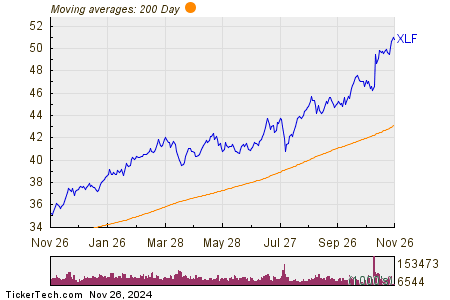Financial Select Sector SPDR Fund Sees Significant Inflow
Notable Changes in ETF Units and Market Performance
Looking at the latest data from ETF Channel, one notable ETF is The Financial Select Sector SPDR Fund (Symbol: XLF), which has seen an impressive inflow of approximately $826.8 million. This increase translates to a 1.6% growth in the number of outstanding units, rising from 1,010,095,427 to 1,026,295,427 in just one week. Among the major companies that make up XLF, Mastercard Inc (Symbol: MA) has dipped about 0.1%, Morgan Stanley (Symbol: MS) is down roughly 2.8%, and Standard and Poors Global Inc (Symbol: SPGI) has decreased by about 0.2%. For a detailed list of XLF’s holdings, please visit the XLF Holdings page.
The chart below illustrates XLF’s price performance over the past year compared to its 200-day moving average:

According to the chart, XLF’s lowest point in its 52-week range was $35.16 per share, and the highest point reached was $51.245. Currently, the last trade recorded for XLF is $50.85. Analyzing the relationship between the current share price and the 200-day moving average can be an effective approach for understanding market trends.
Free Report: Top 8%+ Dividends (paid monthly)
Exchange-traded funds (ETFs) function similarly to stocks, but instead of buying “shares,” investors purchase “units.” These units are traded like stocks, and they can also be created or destroyed to match investor demand. Each week, we track changes in shares outstanding to identify ETFs with significant inflows (indicating the creation of new units) or outflows (signifying the deletion of units). When new units are created, the ETF must buy its underlying holdings, while the destruction of units requires selling those holdings. Thus, notable flows can directly impact the individual stocks within ETFs.
![]() Click here to find out which 9 other ETFs had notable inflows »
Click here to find out which 9 other ETFs had notable inflows »
Also see:
- WAL Stock Predictions
- GFF Market Cap History
- LILM Options Chain
The views and opinions expressed herein are the views and opinions of the author and do not necessarily reflect those of Nasdaq, Inc.

